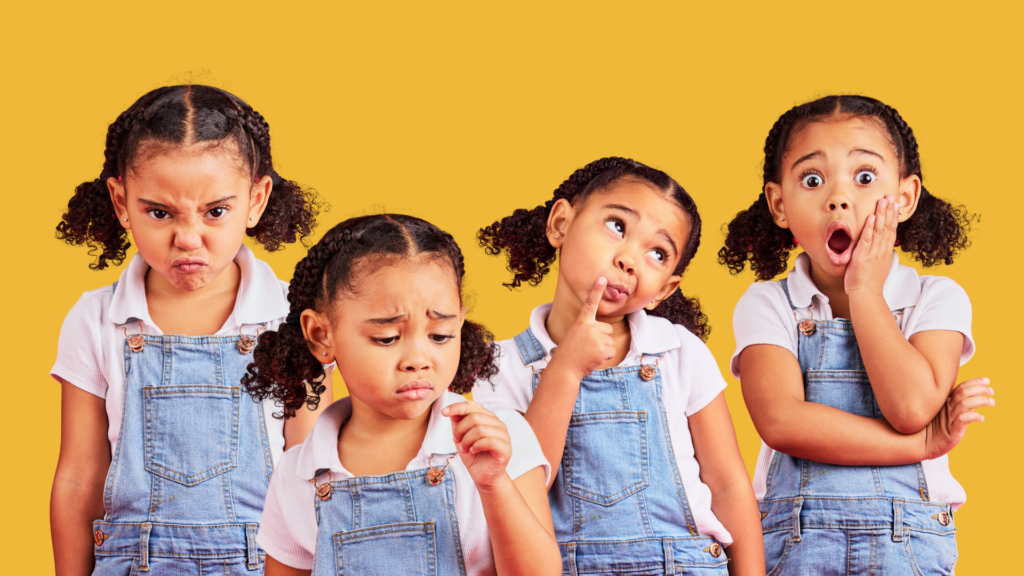Have you ever noticed how much you can say with just a raise, a lower, or a pinch of your eyebrows? We put such little thought into our eyebrows, but these small parts of our body have a big impact on communication. Our eyebrows are key to communicating our emotional life and to enhancing our relationships. Here’s why.
The human face is the most subtle and expressive tool of communication.
Paul Ekman
1. Raising the Eyebrows
It’s a sign of surprise and curiosity, but it can also express excitement and interest, a desire to pay attention and hear more. The skin around our eyes attaches to our eyebrows, which we can lift to look more engaged. If we lift our eyebrows, it’s as if we open our eyes further. With this simple act, we look and feel more interested in what’s going on around us – it invites someone to share more and feel heard. We can connect and gain more from that person as a result.
2. Lowering the Eyebrows
Furrowing the brow can convey concentration, confusion, or displeasure, as a dip in the eyebrow muscles can signal seriousness and concern. When we see these cues, we can respond in ways that help us steer a conversation on track, or to address people’s trouble.
3. Bringing the Eyebrows Together
When our brows come together, it is usually a sign of worry or frustration, of deep thought, of a difficulty, an obstacle, or a cause for concern. Recognising that someone has made this expression in themselves and in others can inform us of when we ought to be more patient, to support them.
Eyes are the windows to the soul, but eyebrows tell the story.
Anonymous

Eyebrows Take the Spotlight
In the movie “Inside Out 2,” the importance of eyebrow movements is brought to life in a fun and insightful way. The characters’ eyebrows play a significant role in expressing their emotions, helping to visually convey their internal experiences. This focus highlights just how powerful and versatile our eyebrows are in nonverbal communication.
For instance, when Joy’s eyebrows are raised, her excitement and enthusiasm are palpable. Conversely, when Sadness’s eyebrows are furrowed, her melancholy and concern are communicated. The movie demonstrates how subtle changes in eyebrow movements can profoundly impact the expression of emotions.
Facial expressions are the universal language of emotion.
Paul Ekman
The Impact When Eyebrows Don’t Move
There are some people who, despite their best efforts, can’t use their eyebrows to convey their emotions. While this might have the unexpected benefit of fewer wrinkles, it often leads to missed and challenging communication moments. When a person’s facial expression doesn’t match their verbal message, it creates a sense of dissonance or confusion for those around them. This disconnect can result in misunderstandings, misinterpretations, and even missed opportunities for connection—all because the subtle, yet powerful, movements of the eyebrows are absent.
1. The Case of the Boy with the Stutter:
I worked with a young boy who had a severe stutter. Despite his difficulty speaking, he was often chosen by his group to present their ideas to the class. His mother believed he was a confident, happy child, unafraid to stand in front of his peers. However, the reality was that his “no” often came across as a “yes” because his facial expression didn’t match his words. His eyebrows didn’t lower or come together to support his refusal, making it difficult for others to understand his true intentions. He also struggled to raise his eyebrows to show surprise, further complicating his ability to communicate effectively.
2. The Case of the Ballet Dancer:
One of my most endearing clients, a talented ballet dancer, faced challenges in her performances. Her ballet teacher mentioned that she struggled to change her facial expressions to reflect the emotions of the dance. Although she always appeared happy, it became clear that she was unable to move her eyebrows to express those emotions. This limitation not only affected her dancing but also her daily interactions—teachers didn’t intervene when she was being bullied because she seemed fine, with no visible signs of distress.
3. The Case of the Contorted Face:
Another client had difficulty using her eyebrows to communicate. One day, she came out to reception and, when asked a question, answered “no” with a contorted expression—wrinkling her nose and mouth in a way that made her look uncomfortable. Because she wasn’t able to use her eyebrows to clearly convey her disagreement, her response led to confusion and miscommunication.
All of these clients learnt to raise, lower, and bring in their eyebrows, helping them to align their facial expressions with their verbal messages. The transformation was remarkable, enabling them to communicate more clearly and confidently, with facial expressions that matched their emotions.
The most important thing in communication is hearing what isn’t said.
Peter Drucker
Why It Matters
Learning how to use eyebrows to better convey nonverbal information is a good thing for all of us, especially in speech pathology where teaching expression through eyebrow usage is critical to a client’s ability to communicate more clearly and be more vocal and confident. This in turn can have important effects on their ability to socialise and express themselves emotionally.
Nonverbal communication forms a social language that is in many ways richer and more fundamental than our words.
Leonard Mlodinow
Assessing and Treating Eyebrow Movements
When someone struggles to use their eyebrows to convey emotions, it’s crucial to assess the underlying causes. Identifying whether the issue comes from muscle weakness, neurological factors, or learned behaviour is the first step. Therapy can then target improving eyebrow movement. This might involve facial exercises to strengthen the muscles around the eyebrows, biofeedback techniques to enhance awareness and control of facial expressions, and strategies to better coordinate verbal and nonverbal communication.
Recognise that this process requires time and persistence, especially for older clients who may have spent years without moving their eyebrows—like one of my recent clients, who is fifteen. With consistent effort, even long-standing patterns can change, leading to clearer and more effective communication.
Ready to Raise Some Eyebrows?
Let’s make your facial expressions as dynamic as your words! Contact us today to start mastering the art of eyebrow communication—because your face has a lot more to say than you think!
Want to be part of something that matters?
Love diving deep into the “why” behind communication?
If you’re a values-driven therapist ready to grow and contribute in a supportive team, we’d love to hear from you.

